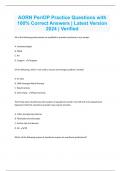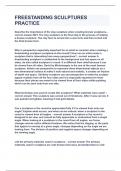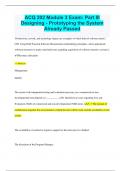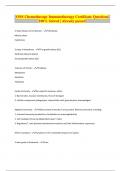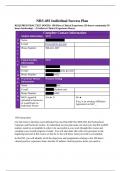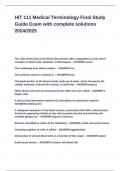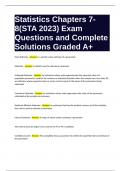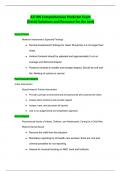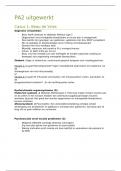Scandura, Essentials of Organizational Behavior, 3e
SAGE Publishing, 2022
Lecture Notes For
Essentials of Organizational Behavior,
Third Edition Scandura
Chapter 1-15
Chapter 1: What Is Organizational Behavior?
Learning Objectives
1.1: Define the concept of organizational behavior (OB).
1.2: List and give examples of the four sources of information used in evidence-based
management (EBM).
1.3: Define critical thinking and explain the critical thinking skills leaders need.
1.4: Discuss five types of outcome variables studied in OB.
1.5: Compare the levels of analysis in OB research.
1.6: Develop plans for using OB research to improve employee job performance.
Chapter Summary
Chapter summary here.
Annotated Chapter Outline
I. A Crisis in Organizations?: Historically, CEOs are fired because of poor company
performance, but recently there is an increase in firing for ethical reasons.
A. Examples
i. Kevin Burns, CEO of Juul, was fired for poor financial performance after
media attention to Juul’s marketing practices, and increased pressure from
health regulators caused a dip in the company’s performance.
ii. Steve Easterbrook, CEO of McDonald’s, was fired for violating company
policy by entering into a consensual relationship with an employee even
though Easterbrook’s performance as a CEO was exceptional.
, Instructor Resource
Scandura, Essentials of Organizational Behavior, 3e
SAGE Publishing, 2022
iii. John Schnatter, Founder and CEO of Papa John’s, stepped down after
backlash from his use of a racial slur during a conference call.
B. What is going on with CEO leadership?
i. Studies show increasing rates of CEO departure from the largest companies
(17.5% in 2018).
a. Most were planned retirements, but 20% of departures were forced.
ii. 2019 is on-pace to have historic levels of CEO departures.
iii. Future leaders must understand nuances of human behavior and honor
ethical principles.
iv. Organizational behavior (OB) addresses leadership challenges like these.
II. What Is Organizational Behavior?: A fairly new, multidisciplinary and multilevel study of
individuals and their behavior in the workplace.
A. Hawthorne Studies: Most agree that OB’s point of origin is the Hawthorne studies
of 1927-1932, conducted by psychologist Elton Mayo
i. First study designed to examine effect of light intensity on plant
productivity
a. Showed productivity increased when lights were dimmed
b. After interviewing workers, found this increase was because of the
extra attention workers received from researchers.
c. Hawthorne effect: Attitude and performance improvements caused
by researchers paying attention to a group of workers
d. Spontaneous collaboration: Mayo’s term for the feelings of
affiliation and trust that arose because of interactions and trust
among workers
ii. Mayo’s second study designed to investigate a new incentive system’s
effect on productivity produced unexpected results.
a. Peer pressure from social subgroups resulted in the informal
standards of production.
b. High-producing workers were expected to reduce production so pay
was more equal within the group.
iii. Hawthorne researchers realized that the human element of organizations
was more important than previously thought and that workers value
attention.
a. Ex: workers are grateful to employers when they provide gifts to
employees, known as empathy wages.
B. Disciplines Contributing to Organizational Behavior: OB is a multidisciplinary
applied field of study that uses ideas and research from multiple disciplines.
i. Examples
, Instructor Resource
Scandura, Essentials of Organizational Behavior, 3e
SAGE Publishing, 2022
a. Industrial/Organizational psychology: studies individual differences
like personality
b. Social psychology: studies individual reactions to work
c. Psychology and economics: studies motivation theory
d. Economics: studies decision-making theory
e. Applied social psychology: studies how people interact in groups
ii. Sociology and anthropology: studies organizational culture and leading
through change
iii. The goal of OB: to improve the functioning of organization and each
employee’s work experience
C. From Theory to Practice
i. Goals of Science
a. Description: what does the process look like?
b. Prediction: will the process occur again? When?
c. Explanation: why is this happening?
d. Control: can we change whether this happens?
ii. Example: Forecasting staffing changes during the holiday season requires
many considerations:
a. Human resource managers base their estimates on prior holiday
seasons—this is description with certain explanation (as they have
a plausible reason why customers are visiting their store this time
of year).
b. Prediction is moderately valuable in this example, ensuring that they
hire an accurate number of seasonal workers.
c. There are minimal amounts of control in this example, as most of
the reasons that stop a customer from visiting the store are beyond
the organization’s control (such as the availability of a toy from
online sources).
iii. Evidence-based management (EBM): translating research into
management practice
III. Evidence-Based Management: Improves a leader’s decisions by disciplined application
of most relevant and current information
A. Four sources of information:
i. Scientific evidence: such as OB research studies on why people quit their
jobs
ii. Organizational evidence: such as exit interviews with employees quitting
the organization
, Instructor Resource
Scandura, Essentials of Organizational Behavior, 3e
SAGE Publishing, 2022
iii. Experiential evidence: such as other managers’ judgments as to why
employees leave
iv. Organizational values or stakeholder concerns: such as the impact of
continual recruitment on Human Resources or employees experiencing
reasons to quit
B. Requirements for Successful EBM
i. For EBM, leaders must have
a. The ability: basic skills and competencies
b. The motivation: behavioral beliefs, behavioral control, and
normative beliefs
c. The opportunity: support that overcomes barriers to EBM
ii. Leaders must be involved at every level and collaborate with researchers.
C. Standards of EBM
i. Stop treating old ideas as if they were brand new
a. A cynical workforce may be sensitive to would-be innovations that
closely resemble older management fads (―empowerment‖ of the
1980s versus ―engagement‖ today).
ii. Be suspicious of ―breakthrough‖ studies and ideas
iii. Develop and celebrate collective brilliance
iv. Emphasize drawbacks as well as virtues
v. Use success (and failure) stories to illustrate sound practices, but not in
place of a valid research method
vi. Adopt a neutral stance toward ideologies and theories
vii. Critical thinking, or learning by questioning everything, is important for
effectively using these standards.
IV. What is Critical Thinking?: Persistent examination of any belief or knowledge in light of
evidence that supports it. It is a self-directed, self-disciplined, self-monitored, and
self-corrective way of thinking.
A. Three Parts of Critical Thinking
i. Elements of thought (reasoning)
ii. Intellectual standards
iii. Intellectual traits—developed through the consistent application of
intellectual standards to the elements of thought
B. Critical Thinking Skills (as outlined in Table 1.1)
i. Logic
ii. Reflection
iii. Dual processing
iv. Attention to detail

